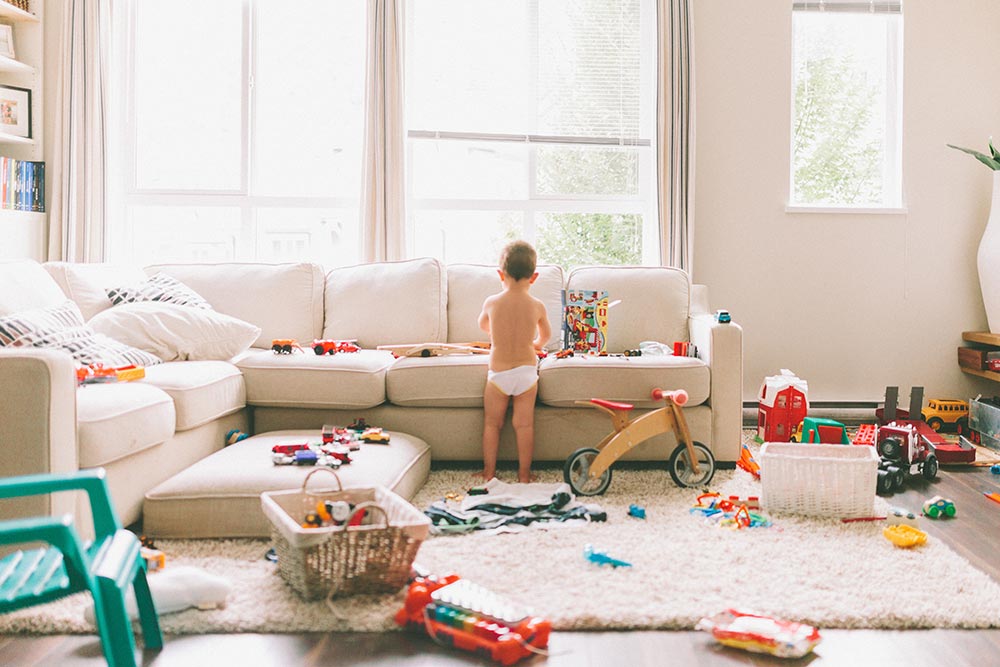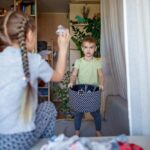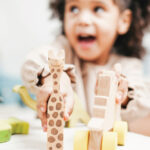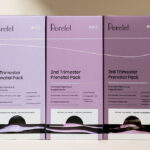How to Declutter Kids Toys in 10 Steps

Decluttering is not a one-and-done type of thing—it’s a process that requires maintenance.
Does your home feel like a toy store after a tornado? Are LEGOs inflicting unbearable pain on your unsuspecting feet? You are not alone!
The good news is that decluttering kids’ toys doesn’t have to be painful.
With a few creative strategies, you can cut the clutter, create an easy toy storage system, and even get your kids to help out!
Step 1: Get Clear on Your Goal
Before you throw a bunch of random children’s toys into garbage bags, take a minute to decide what you want to accomplish.
Are you:
- Hoping to cut down the number of toys so your home feels less chaotic?
- Clearing out outgrown and broken toys to make room for better ones?
- Setting up a more minimalist toy collection with only what your child plays with?
Having a clear goal will make the process much easier. Otherwise, you’ll get stuck debating with yourself about whether to keep that cool red toy car that’s missing a wheel (spoiler alert: don’t).
Step 2: Start with the No-Brainers—Broken and Outgrown Toys
The easiest way to declutter toys is to start with the stuff that needs to go. Grab those toys with broken or missing pieces and outgrown items and get them out of the way.
How to sort fast:
- If the toy is broken beyond repair, throw it out.
- If your child has outgrown the toy, donate it.
- If it’s missing essential pieces, it’s time to let it go.
This first pass helps remove a nice chunk of toys, making the next steps a lot smoother.
Step 3: Cut Down on Dupes
Eliminate duplicates. They can take up valuable space, and let’s be real—kids always have their favorites.
How to decide what stays:
- Pick faves. If your kid has four dolls but always sleeps with one, that’s the one to keep.
- Choose variety over quantity. A few different types of toy cars are better than ten of the same one.
- Rotate, don’t hoard. If they insist they love them all, store a few away and swap them out later.
Fewer duplicates = less clutter, easier clean-up, and more appreciation for what’s left.
Step 4: Sort by Category to Make Decluttering Easier
Now that you’ve cut down the excess, it’s time to organize what’s left. Grouping toys by type helps you see what your child has—and what’s taking up space.
Try sorting like this:
- Building toys: LEGOs, blocks, magnetic tiles
- Figures & dolls: action figures, Barbies, stuffed animals
- Games & puzzles: board games, card games, educational puzzles
- Creative play: art supplies, dress-up clothes, musical instruments
Seeing everything together makes it crystal clear where there’s too much of one thing.
If there are ten board games, but only three are played, it may be time to donate the extras.
Step 5: Rotate Toys Instead of Keeping Everything Out
If your child has so many toys that they barely notice half of them, a toy rotation system can make things feel new—without adding more stuff.
How to do it:
- Pack half the toys in labeled storage bins and put them out of sight.
- Swap out a few stored toys every few weeks for those in use.
- If a toy sits in storage for months and hasn’t been missed? It’s time to donate it.
Fun Fact: children tend to play more when they have fewer options. Plus, it keeps their toys fresh without cluttering the house.
Step 6: Give Toys a Home
Toys can spread like wildfire when they don’t have a designated space. Whether it’s a full playroom, a section of the living room, or just one toy box, every toy needs a place to go.
Make storage easy for everyone:
- Use clear storage bins so your little ones can see what’s inside.
- Label shelves to make finding (and putting away) toys easier.
- Create specific toy zones—one area for LEGOs, another for board games, and so on.
When kids know exactly where things should go, they’re more likely to put them back.
Step 7: Make Clean-Up Part of Playtime
No matter how organized your system is, toys won’t clean themselves. The trick? Making clean-up a habit—without nagging.
How to get kids to help:
- Set an egg timer and turn it into a fun game.
- Give simple, clear instructions.
- Make it rewarding. A sticker chart or extra bedtime story can work wonders.
The younger children are when they learn to clean up their messes, the easier it will be for them in the long run.
Step 8: Be Mindful About Bringing in New Toys
Decluttering won’t help if new toys keep coming in. The key is being intentional about what enters your home. More is not always better.
Smart strategies to prevent toy overload:
- Use a wishlist for birthdays and holidays. This will help prevent toy overload.
- Follow a one-in, one-out rule. Every time a new toy comes in, an old toy goes out.
- Choose high-quality toys. Fewer, better toys last longer and create less mess.
Keeping new toy clutter in check makes long-term decluttering easier.
Step 9: Keep Only the Best, Not the Most
Kids don’t need a million toys—they need the right ones. A minimalist approach helps kids focus and play more creatively.
How to simplify without guilt:
- Keep their favorites, and ditch the rest. If they don’t love it, they won’t miss it.
- Choose open-ended toys. Blocks, LEGOs, and art supplies last longer than those cheap trendy toys.
- Avoid the “just in case” toys. If they haven’t played with it in a bit, it’s a safe bet it’s not a fave.
Less clutter = less stress and more fun for younger kids.
Step 10: Teach Kids to Let Go
Letting go is hard—even for adults. Teaching kids to donate toys helps them develop generosity and keeps the clutter in check.
How to make it easier:
- Explain that their old toys can make another child happy.
- Let them choose what to donate. Giving them control makes it easier.
- Use a “maybe” box. If they don’t ask for it in a month, it’s time to let go.
The goal isn’t just a clean house—it’s helping kids learn to manage their stuff.
Maintaining a Clutter-Free Home
Decluttering is not a one-and-done type of thing—it’s a process that requires maintenance.
Keep up with your system by:
- Regularly reassessing: Set a reminder every few months to declutter toys again.
- Involving kids: Encourage them to participate in organizing their own space.
- Sticking to boundaries: Use the wishlist and one-in, one-out rule to prevent clutter from creeping back in.
Following these decluttering tips will create a home where play is fun, clean-up is easy, and stress is minimized.








